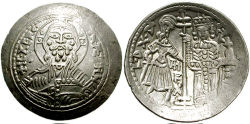
Scyphate
Encyclopedia


Numismatics
Numismatics is the study or collection of currency, including coins, tokens, paper money, and related objects. While numismatists are often characterized as students or collectors of coins, the discipline also includes the broader study of money and other payment media used to resolve debts and the...
to refer to the concave or "cup-shaped" Byzantine coins of the 11th–14th centuries.
This usage emerged in the 19th century, when the term scyphatus, attested in south Italian
South Italy
South Italy is one of the five official statistical regions of Italy used by the National Institute of Statistics , a first level NUTS region and a European Parliament constituency. South Italy encompasses six of the country's 20 regions:*Abruzzo...
documents of the 11th and 12th centuries, was erroneously interpreted as deriving from the Greek
Greek language
Greek is an independent branch of the Indo-European family of languages. Native to the southern Balkans, it has the longest documented history of any Indo-European language, spanning 34 centuries of written records. Its writing system has been the Greek alphabet for the majority of its history;...
word skyphos (σκύφος, "cup"). In reality, the term probably derives from the Arabic word shafah, "edge, rim", and refers to the distinctive and conspicuous border of the early histamena
Histamenon
Histamenon was the name given to the gold Byzantine solidus when the slightly lighter tetarteron was introduced in the 960s. To distinguish the two, the histamenon was changed in form from the original solidus, becoming wider and thinner, as well as concave in form. Later usually shortened to...
gold coins. Due to this misunderstanding, the term "scyphate" has been widely applied to the concave gold, silver and copper coins of the late Byzantine Empire and the foreign issues imitating it. These coins are more properly designated as trachea (sing. trachy, from Greek τραχύ, "rough, uneven").

